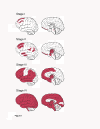Chronic traumatic encephalopathy: a spectrum of neuropathological changes following repetitive brain trauma in athletes and military personnel
- PMID: 24423082
- PMCID: PMC3979082
- DOI: 10.1186/alzrt234
Chronic traumatic encephalopathy: a spectrum of neuropathological changes following repetitive brain trauma in athletes and military personnel
Abstract
Chronic traumatic encephalopathy (CTE) is a progressive neurodegenerative disease that occurs in association with repetitive traumatic brain injury experienced in sport and military service. In most instances, the clinical symptoms of the disease begin after a long period of latency ranging from several years to several decades. The initial symptoms are typically insidious, consisting of irritability, impulsivity, aggression, depression, short-term memory loss and heightened suicidality. The symptoms progress slowly over decades to include cognitive deficits and dementia. The pathology of CTE is characterized by the accumulation of phosphorylated tau protein in neurons and astrocytes in a pattern that is unique from other tauopathies, including Alzheimer's disease. The hyperphosphorylated tau abnormalities begin focally, as perivascular neurofibrillary tangles and neurites at the depths of the cerebral sulci, and then spread to involve superficial layers of adjacent cortex before becoming a widespread degeneration affecting medial temporal lobe structures, diencephalon and brainstem. Most instances of CTE (>85% of cases) show abnormal accumulations of phosphorylated 43 kDa TAR DNA binding protein that are partially colocalized with phosphorylated tau protein. As CTE is characterized pathologically by frontal and temporal lobe atrophy, by abnormal deposits of phosphorylated tau and by 43 kDa TAR DNA binding protein and is associated clinically with behavioral and personality changes, as well as cognitive impairments, CTE is increasingly categorized as an acquired frontotemporal lobar degeneration. Currently, some of the greatest challenges are that CTE cannot be diagnosed during life and the incidence and prevalence of the disorder remain uncertain. Furthermore, the contribution of age, gender, genetics, stress, alcohol and substance abuse to the development of CTE remains to be determined.
Figures






References
-
- Osnato M. Postconcussion neurosis-traumatic encephalitis – a conception of postconcussion phenomena. Arch NeurPsych. 1927;6:181–214. doi: 10.1001/archneurpsyc.1927.02210020025002. - DOI
-
- Martland H. Punch drunk. JAMA. 1928;6:1103–1107. doi: 10.1001/jama.1928.02700150029009. - DOI
-
- Millsbaugh JA. Dementia pugilistica. US Naval Med Bulletin. 1937;6:297–361.
-
- Critchley M. Punch-Drunk Syndromes: the Chronic Traumatic Encephalopathy of Boxers. Hommage a Clovis Vincent. Paris: Maloin; 1949.
Publication types
Grants and funding
LinkOut - more resources
Full Text Sources
Other Literature Sources
Research Materials

